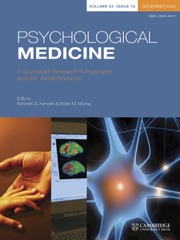Crossref Citations
This article has been cited by the following publications. This list is generated based on data provided by
Crossref.
Marwaha, Steven
Broome, Matthew R.
Bebbington, Paul E.
Kuipers, Elizabeth
and
Freeman, Daniel
2014.
Mood Instability and Psychosis: Analyses of British National Survey Data.
Schizophrenia Bulletin,
Vol. 40,
Issue. 2,
p.
269.
Fournier, Margot
Ferrari, Carina
Baumann, Philipp S.
Polari, Andrea
Monin, Aline
Bellier-Teichmann, Tanja
Wulff, Jacob
Pappan, Kirk L.
Cuenod, Michel
Conus, Philippe
and
Do, Kim Q.
2014.
Impaired Metabolic Reactivity to Oxidative Stress in Early Psychosis Patients.
Schizophrenia Bulletin,
Vol. 40,
Issue. 5,
p.
973.
Day, Fern L.
Valmaggia, Lucia R.
Mondelli, Valeria
Papadopoulos, Andrew
Papadopoulos, Irene
Pariante, Carmine M.
and
McGuire, Philip
2014.
Blunted Cortisol Awakening Response in People at Ultra High Risk of Developing Psychosis.
Schizophrenia Research,
Vol. 158,
Issue. 1-3,
p.
25.
Valmaggia, L.R.
Day, F.L.
Kroll, J.
Laing, J.
Byrne, M.
Fusar-Poli, P.
and
McGuire, P.
2015.
Bullying victimisation and paranoid ideation in people at ultra high risk for psychosis.
Schizophrenia Research,
Vol. 168,
Issue. 1-2,
p.
68.
Valmaggia, Lucia R.
Day, Fern
Garety, Philippa
Freeman, Daniel
Antley, Angus
Slater, Mel
Swapp, David
Myin-Germeys, Inez
and
McGuire, Philip
2015.
Social defeat predicts paranoid appraisals in people at high risk for psychosis.
Schizophrenia Research,
Vol. 168,
Issue. 1-2,
p.
16.
Grammenos, Dionysios
and
Barker, Steven A.
2015.
On the transmethylation hypothesis: stress, N,N-dimethyltryptamine, and positive symptoms of psychosis.
Journal of Neural Transmission,
Vol. 122,
Issue. 6,
p.
733.
Wigman, J. T. W.
van Os, J.
Borsboom, D.
Wardenaar, K. J.
Epskamp, S.
Klippel, A.
Viechtbauer, W.
Myin-Germeys, I.
and
Wichers, M.
2015.
Exploring the underlying structure of mental disorders: cross-diagnostic differences and similarities from a network perspective using both a top-down and a bottom-up approach.
Psychological Medicine,
Vol. 45,
Issue. 11,
p.
2375.
Gevonden, M. J.
Myin-Germeys, I.
van den Brink, W.
van Os, J.
Selten, J. P.
and
Booij, J.
2015.
Psychotic reactions to daily life stress and dopamine function in people with severe hearing impairment.
Psychological Medicine,
Vol. 45,
Issue. 8,
p.
1665.
Goodall, Karen
Rush, Robert
Grünwald, Lisa
Darling, Stephen
and
Tiliopoulos, Niko
2015.
Attachment as a partial mediator of the relationship between emotional abuse and schizotypy.
Psychiatry Research,
Vol. 230,
Issue. 2,
p.
531.
Jensen, Laura Schärfe
Overgaard, Charlotte
Garne, Jens Peter
Carlsen, Kathrine
Bøggild, Henrik
and
Fonager, Kirsten
2016.
Can registry data be used as a proxy for perceived stress? A cross-sectional study.
Annals of Epidemiology,
Vol. 26,
Issue. 7,
p.
493.
Steullet, P.
Cabungcal, J.H.
Monin, A.
Dwir, D.
O'Donnell, P.
Cuenod, M.
and
Do, K.Q.
2016.
Redox dysregulation, neuroinflammation, and NMDA receptor hypofunction: A “central hub” in schizophrenia pathophysiology?.
Schizophrenia Research,
Vol. 176,
Issue. 1,
p.
41.
Mazor, Yael
Gelkopf, Marc
Mueser, Kim T.
and
Roe, David
2016.
Posttraumatic Growth in Psychosis.
Frontiers in Psychiatry,
Vol. 7,
Issue. ,
Upthegrove, Rachel
Ives, Jonathan
Broome, Matthew R.
Caldwell, Kimberly
Wood, Stephen J.
and
Oyebode, Femi
2016.
Auditory verbal hallucinations in first-episode psychosis: a phenomenological investigation.
BJPsych Open,
Vol. 2,
Issue. 1,
p.
88.
Upthegrove, Rachel
Marwaha, Steven
and
Birchwood, Max
2016.
Depression and Schizophrenia: Cause, Consequence or Trans-diagnostic Issue?.
Schizophrenia Bulletin,
p.
sbw097.
Cristóbal-Narváez, Paula
Sheinbaum, Tamara
Ballespí, Sergi
Mitjavila, Mercè
Myin-Germeys, Inez
Kwapil, Thomas R.
Barrantes-Vidal, Neus
and
van Winkel, Ruud
2016.
Impact of Adverse Childhood Experiences on Psychotic-Like Symptoms and Stress Reactivity in Daily Life in Nonclinical Young Adults.
PLOS ONE,
Vol. 11,
Issue. 4,
p.
e0153557.
Shaikh, Madiha
Ellett, Lyn
Dutt, Anirban
Day, Fern
Laing, Jennifer
Kroll, Jasmine
Petrella, Sabrina
McGuire, Philip
and
Valmaggia, Lucia R.
2016.
Perceived ethnic discrimination and persecutory paranoia in individuals at ultra-high risk for psychosis.
Psychiatry Research,
Vol. 241,
Issue. ,
p.
309.
Brzózka, M.M.
Unterbarnscheidt, T.
Schwab, M.H.
and
Rossner, M.J.
2016.
OSO paradigm – A rapid behavioral screening method for acute psychosocial stress reactivity in mice.
Neuroscience,
Vol. 314,
Issue. ,
p.
1.
Gevonden, Martin
Myin-Germeys, Inez
Wichers, Marieke
Booij, Jan
van den Brink, Wim
van Winkel, Ruud
and
Selten, Jean-Paul
2016.
Reactivity to social stress in ethnic minority men.
Psychiatry Research,
Vol. 246,
Issue. ,
p.
629.
Krkovic, Katarina
Moritz, Steffen
and
Lincoln, Tania M.
2017.
Neurocognitive deficits or stress overload: Why do individuals with schizophrenia show poor performance in neurocognitive tests?.
Schizophrenia Research,
Vol. 183,
Issue. ,
p.
151.
Steel, C.
Hardy, A.
Smith, B.
Wykes, T.
Rose, S.
Enright, S.
Hardcastle, M.
Landau, S.
Baksh, M. F.
Gottlieb, J. D.
Rose, D.
and
Mueser, K. T.
2017.
Cognitive–behaviour therapy for post-traumatic stress in schizophrenia. A randomized controlled trial.
Psychological Medicine,
Vol. 47,
Issue. 1,
p.
43.




